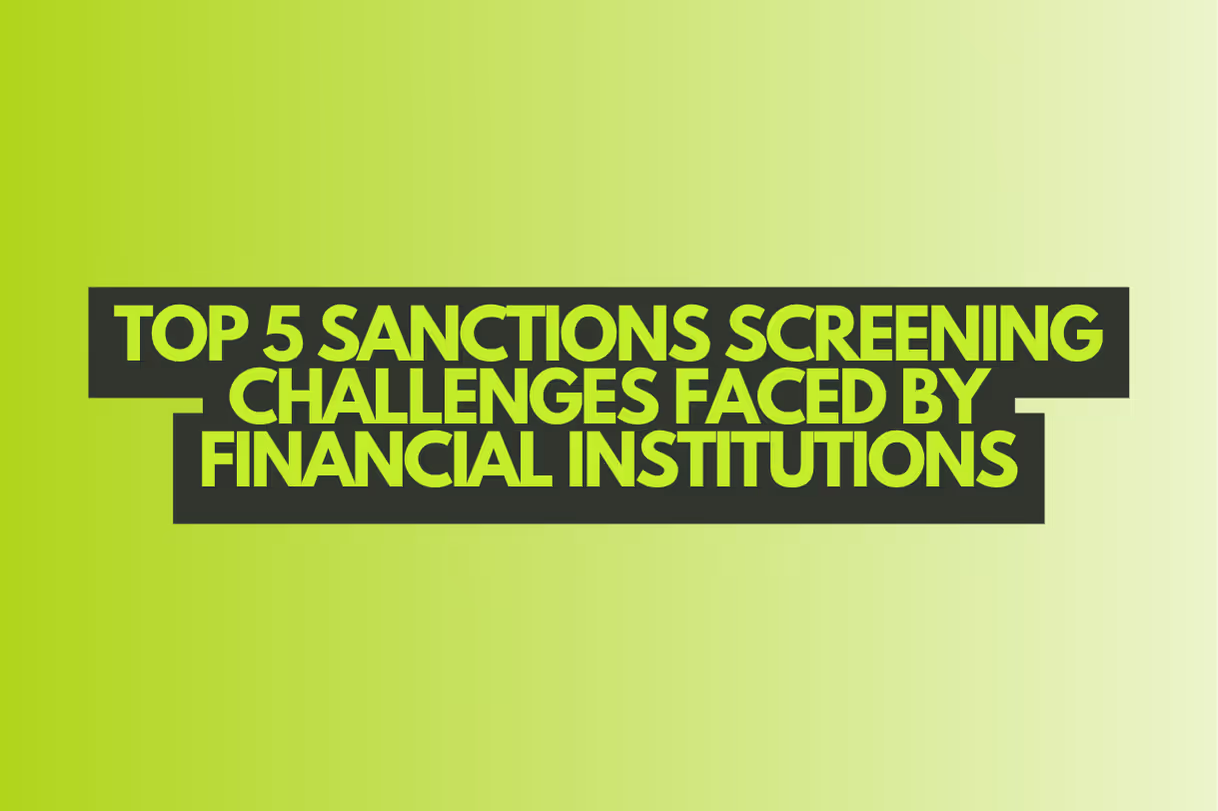
The Top 5 Sanctions Screening Challenges Faced by Financial Institutions
Sanctions screening remains a cornerstone of compliance for financial institutions, yet it comes with significant challenges. Common issues include poor data quality, which leads to missed or false matches; high false positive rates that overwhelm compliance teams; difficulties in managing frequent sanctions list updates; and the complexity of screening layered or opaque entity structures. Inadequate investigation and escalation workflows can compromise the effectiveness of even well-designed screening systems. To address these challenges, institutions must invest in data standardization, algorithm calibration, automated list management, beneficial ownership transparency, and strong case management processes. A risk-based, technology-enabled approach backed by clear governance is essential for building a resilient and efficient sanctions screening program.
Sanctions screening is a critical control in any financial institution’s compliance framework, designed to prevent prohibited transactions and customer relationships involving sanctioned individuals, entities, or jurisdictions. However, as global sanctions lists grow more complex and enforcement expectations increase, the effectiveness of screening programs is often tested. Financial institutions face a range of challenges that can compromise their ability to detect and escalate sanctions risks accurately.
This article explores five of the most common pain points in sanctions screening and offers practical guidance on how to address them. By understanding these challenges and implementing targeted solutions, institutions can enhance their screening performance and reduce their exposure to compliance failures.
Challenge 1: Data Quality and Standardization
One of the most persistent issues in sanctions screening is poor data quality. Incomplete, inconsistent, or unstructured customer data can lead to missed matches or an overwhelming number of false positives. Misspellings, varying name formats, and missing identifiers can cause screening tools to fail in detecting true matches with sanctioned parties.
To overcome this, institutions must invest in data cleansing and standardization at every stage of the customer lifecycle. This includes validating input data, using common formats for names and dates, and enforcing consistent data entry standards across systems. Improving data quality not only boosts match accuracy but also makes it easier to analyze screening outcomes and audit decisions.
Challenge 2: High False Positive Rates
A high volume of false positives is one of the most operationally burdensome aspects of sanctions screening. False positives occur when the screening system flags an entity or transaction as a potential match, but further investigation determines it is not linked to a sanctioned individual or entity. Excessive false positives can slow down operations and divert resources from genuine risk cases.
Mitigating this challenge requires refining the screening system's match logic. Institutions should regularly calibrate their fuzzy matching algorithms, use secondary data points (such as date of birth or location), and apply risk-based thresholds tailored to customer profiles. In addition, using tiered screening approaches and prioritizing high-risk matches can help streamline investigations and reduce alert fatigue.
Challenge 3: Managing List Updates and Localized Lists
Sanctions lists are updated frequently, sometimes with immediate effect and without prior notice. Institutions must not only stay current with major international lists like OFAC, UN, and EU but also account for local or industry-specific lists. Delays or errors in updating these lists can result in inadvertent breaches of sanctions.
To manage this effectively, financial institutions should automate the ingestion and update of sanctions lists through trusted providers or APIs. A centralised governance function should be responsible for overseeing list management and ensuring updates are documented and communicated across relevant teams. Robust change control procedures and regular reconciliation checks can further reduce the risk of omissions.
Challenge 4: Screening Complex Entity Structures
Identifying sanctions exposure is particularly challenging when screening entities with layered ownership or indirect ties to sanctioned individuals. This is common in cases involving shell companies, trusts, or investment vehicles where the Ultimate Beneficial Owner (UBO) may not be immediately visible. Screening based solely on customer names will fail to detect these hidden risks.
Addressing this challenge requires integrating sanctions screening with beneficial ownership analysis and corporate structure mapping. Institutions should gather and maintain accurate UBO data as part of their customer due diligence process. Screening tools that can assess control relationships and flag indirect exposure are increasingly essential for full compliance with modern sanctions regimes.
Challenge 5: Inadequate Investigation and Escalation Workflows
Even when potential matches are correctly flagged, weak investigation or escalation procedures can undermine sanctions compliance. This includes unclear ownership of alerts, inconsistent decision-making, and inadequate documentation of outcomes. Such gaps not only increase operational risk but can also create audit and regulatory vulnerabilities.
To strengthen workflows, institutions should implement clearly defined, tiered investigation processes with appropriate training for analysts at each level. Case management systems should support detailed record-keeping, audit trails, and metrics tracking. Escalation criteria should be standardised, with legal or compliance oversight for complex or high-risk cases. Regular quality assurance reviews can help ensure that investigations are handled consistently and effectively.
{{snippets-guide}}
Final Thoughts: Building a Stronger Sanctions Screening Program
Sanctions screening is inherently complex, and even well-resourced institutions face ongoing challenges. However, by addressing the common issues of data quality, false positives, list management, complex entity structures, and escalation workflows, organizations can materially improve the effectiveness of their programs.
A proactive and risk-based approach is key. This includes investing in technology, training, and governance to support efficient, accurate screening processes. As sanctions regimes evolve and regulatory scrutiny intensifies, institutions that build resilience into their screening frameworks will be best positioned to manage risk and maintain compliance.
sanctions.io is a highly reliable and cost-effective solution for real-time screening. AI-powered and with an enterprise-grade API with 99.99% uptime are reasons why customers globally trust us with their compliance efforts and sanctions screening needs.
To learn more about how our sanctions, PEP, and criminal watchlist screening service can support your organization's compliance program: Book a free Discovery Call.
We also encourage you to take advantage of our free 7-day trial to get started with your sanctions and AML screening (no credit card is required).



